#Asian Weapons
Explore tagged Tumblr posts
Text
The sword of the day is the chakram.

The chakram is a throwing weapon from the Indian subcontinent, used by Sikhs until the 19th century. It consists of a flat metal ring sharpened along the entire outside edge. Warriors would wear several of them on their arms or stacked on their turbans. In battle, the chakram would be thrown like a frisbee, or sometimes spun on the finger to generate a surprisingly powerful throw. In folklore and legend, one of the earliest references to the chakram is found in the Mahabharata, a 5th century epic, where this weapon is said to be wielded by Vishnu, as well as one of his incarnations, Krishna.
477 notes
·
View notes
Text
instagram
The Kanabo is quickly becoming one of my favorite weapons in my collection! 👹
W/ the world of premiere of Assassin's Creed Shadows I hope to see this beauty used all of it's armor crushing glory! ⚔️
Stay tuned for more demonstrations of this things destructive capabilites! 💪🏿👹🙌🏿
#Kult of Athena#KultOfAthena#WorldOfKOA#Simply Samurai#SimplySamurai#Seto Waddell#Spencer Waddell#Kanabo#club#mace#Japanese Weapons#Asian Weapons#Assassin's Creed#Assassin's Creed Shadows#AC Shadows#Oni#Oni Kanabo#KOA Exclusive#Japanese Folklore#video games#Instagram
7 notes
·
View notes
Text
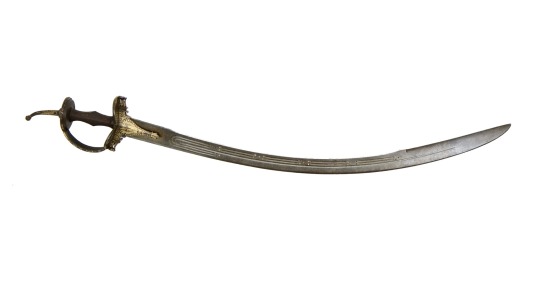
Large Mughal saber.
India. 17th to 18th Century.
Mandarin Mansion Antiques.
#art#culture#history#asian history#asian weapons#indian history#India#indian#mughal#military history#early modern period#early modern history#modern history#sword#saber
2 notes
·
View notes
Note
How about a knife which turns anything it kills into dust
Or a two bladed sword like Darth Maul style for some kind of tempel guard or something, where they dont need to move around a lot and can always have the sword unsheathed cause that seams to be the most annoying part, of cource high roof and a lot of space would probably be necessary to move around properly. Though it would probably need to be some kind of straight blade like european longswords rather then a katana sry
K O B O L D K A T A P U L T ! ! !
A bone necklace which makes one of your eyes glow blue if you play the trombone
Or how about a classic: FIRE SWORD
Or counter point: ICE SWORD
OR counter counter point: ELECTRIC/THUNDER SWORD
OR counter counter counter point: FLOATING SWORD
Or, if none of the rest is any good, how about an entire arena full of 78 kittens all cuddling with ME
I sort of have the principles of "knife that turns people into dust" thing built into a certain sword called the Sakurajimaken, an old battle sword hidden in a protected shrine on a secluded temple island that instead of leaving wounds, leaves sakura trails, instead of blood, Cherry Blossoms shoot from the enemy, and if you cut a limb off, it disentigrates into the bloss. too.
Also, the double-bladed sword did in fact exist and is actually suprisingly practical in some situations, and would be an excellent fit for a temple guard. I could see if i couldnt make a curved version, but Asian history is no stranger to a straightsword.
Also, elemental blades can be really cool.. If done well. I'll be working on some concepts there, too.
Also, to compensate you for your ideas, 78 kittens are being shipped to you RIGHT NOW!!!
#japan#culture#asia#history#samurai#war#creativity#japanese#shinto#swords#sword design#concept#weapon design#asian weapons#ask me stuff#ask me questions#ask me anything#asks#ask#tumblr asks
4 notes
·
View notes
Text
More Female Dao and Male Jian!!!
The weapon OP is using is a 刀 (dao1; one-edged blade/sabre).
[eng by me]
1K notes
·
View notes
Note
Hello!! Firstly, I love your blog, thank you so much for providing such useful and interesting information! Secondly, how was pirate culture in the Qing dynasty? Especially in regards to their clothes. I'd like to make an Earth Kingdom pirate oc, so I've been taking some inspiration from Jiang from the comics and Ching Shih, a famous pirate, but I'd love to see any information you could provide about this topic! Thank you!
What a neat question! The pirate culture during the Qing Dynasty was really interesting. Since I know I have a lot of historical fashion fans follow this blog, I'll show you the inspiration board I created first and then try to connect it to the Avatar world. If you're interested in the history of Qing era pirates or the greater context behind my clothing recommendations, you can click on the "Keep Reading" line.
So what might the pirates of the Qing Dynasty have worn?
Since Qing Dynasty pirates spent most of their time in the South China Sea and docked along the China-Vietnam borderlands--- both the Qing Dynasty and the Tây Sơn Dynasty had employed these pirates at different points in time--- they were likely a mix of Chinese and Vietnamese culturally, if not ethnically. Their clothing would reflect this, as well as incorporating fabrics and cuts that would be suitable for a tropical climate. In general, their wardrobe would be very Southeast Asian in style.
Since you seem to be designing a female OC, I figured I'd make a collage of clothing and accessories that a Qing Dynasty lady pirate might have.
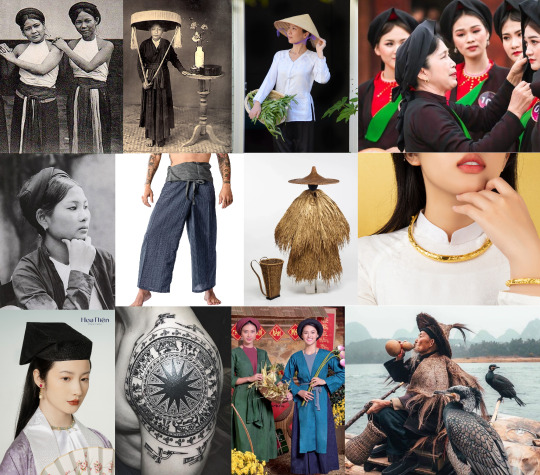
Headwear

Khăn lươn (Vietnamese Women's Headwrap) - Used to keep hair neat and out of the way. It's like a halfway point between a turban and a hairband.
Khăn mỏ quạ (Vietnamese Women's Headscarf) - A bandana that Vietnamese women would wear over their Khăn lươn to shield their hair from the sun. It literally means "Crow's Beak Scarf", because the bandana forms a triangle shape at the front.
Mũ chữ Đinh (Vietnamese Military Officer's Hat) - Many Qing Dynasty pirates would offer their services to the Tây Sơn Dynasty (Vietnamese) navy. I can imagine some pirates wearing these hats as a spoil of war.
Nón lá (Asian Conical Hat) - A traditional hat that is commonly worn in Asia by any profession that labors outside. It's probably the hat most associated with East and Southeast Asia.
Đinh Tự (Vietnamese Women's Hat) - A giant, wide-brimmed hat made from dried palm leaves--- it's basically an Asian conical hat on steroids. Whereas the nón lá is relatively gender-neutral, the dinh tự is considered a feminine hat.
Tops

Yếm / Dudou (Vietnamese/Chinese Halter Top) - Fun Fact: Its original purpose was to keep the belly warm, as the stomach is the sea of chi!
Áo gấm (Vietnamese Tunic) - A thin overcoat worn over the yếm. It's often fastened with a sash.
Áo bà ba (Vietnamese Folk Shirt) - A lightweight shirt with slits on the side.
Suoyi (Chinese Folk Raincoat) - A cloak made out of local materials such as palm leaves and grass. It was also worn by laborers in Vietnam, Japan, and Korea.
Bottoms

Kangkeng Le (Thai Fisherman Pants) - They're from Thailand, but I've seen them worn in other parts of Southeast Asia.
Váy (Vietnamese Skirt)
Miscellaneous Speculation
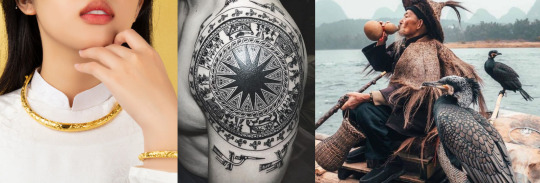
Kiềng (Vietnamese Gold Necklace) - Traditionally, gold or silver Vietnamese/Chinese necklaces were solid rings of metal, rather than being composed of small chain links like European necklaces. I imagine a powerful Asian pirate queen would wear at least three kiềng necklaces.
Tattoos - Since Confucian cultures traditionally considered body modification (including cutting your own hair) to be a sign of rebellion and criminality, tattoos would be the perfect status symbol for an Asian pirate! For a uniquely Vietnamese look, you could try incorporating ancient Vietnamese (Dong Son style) patterns to your design. Alternatively, they could have "protection charm" tattoos on their body, to ensure that the spirits watch over them while at sea or during battle.
Cormorants (Fishing Birds) - Historically, the fishermen of China and Vietnam have trained these species of bird to catch fish for them. I think it would be really cool if your pirate OC had some bird companions.
Weapons
Going to lean into the Vietnamese influence for the weapons as well. Most Vietnamese weapons were heavily inspired by Chinese weapons, but with uniquely Vietnamese touches. Generally, these weapons tended to have more tapered blades, metal engravings with floral patterns, and rattan-corded grips with smaller guards compared to their Chinese counterparts.
Dadao/Trường đao (Chinese/Vietnamese Machetes)

Jian/Kiem (Chinese/Vietnamese Doubled-Edged Swords)

Changdao/Guőm truòng (Chinese/Vietnamese Two-Handed Swords) - Fun fact: These swords were really popular with Chinese and Japanese pirates during the Ming Dynasty, as well.
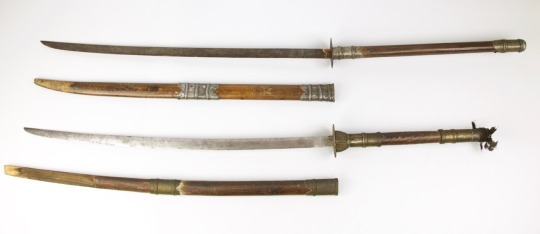
Niuweidao - I don't think there's a Vietnamese version of Oxtail Sabers. Anyways, I've discussed Zuko's trademark swords at length elsewhere. They're civilian weapons that look very pirate-y to me.

Who would the Earth Kingdom pirates be? How would they make a living?

It has been shown that their is a Vietnam analog in the EK, as I've posted about before. The Swampbenders have some Vietnamese inspiration, as well. So the main base operations for EK pirates might have been that EK village that Zuko and Iroh begged in. Maybe the jerk that Zuko stole the swords from was a pirate.
Considering that Froggy Swamp denizens and other Water Tribers would probably be marginalized by EK society, I think their would be good reason for them to become pirates. Especially since waterbending would obviously be a very useful skill to have at sea. Also, since the Northern Water Tribe is shown to be a bit sexist, I could see the surprisingly not-as-sexist world of EK piracy being especially appealing to the ladies of the NWT. As far as EK natives go, farmers and fishermen who've been displaced by the Fire Nation would probably also turn to piracy. Similarly, jaded or corrupt Earth Kingdom and Fire Nation naval officers might switch to piracy, as well. What drives a person to piracy would definitely inform their clothing choices and weaponry.
Like the real-life pirates of the Qing Dynasty, Earth Kingdom pirates likely have no real national loyalties. If you paid them enough, they'd be willing to fight for either the Fire Nation or the Earth Kingdom. You also have to pay them off to cross their territory unscathed. Pirates raid merchant and military ships alike. For refugees who could afford it, they likely paid pirates to smuggle them into Ba Sing Se. Pirates probably also smuggled goods between nations, as well as drugs.
I also think Earth Kingdom pirates would worship water-related spirits, like Yue (+ the Ocean Spirit) or the Painted Lady. Perhaps they'd lay out offerings to spirit alters they'd have onboard or even "feed" the offerings to the seas themselves.
The Greater Context of Chinese Qing Dynasty Piracy
Who were the pirates of the Qing Dynasty?

The pirates of Qing Dynasty were predominantly made up of former farmers and fishermen. During this period, population growth in China lead to land shortages and many farmers lost their land either from being unable to keep up with rising taxes or outright theft from corrupt officials. Fishermen turned to piracy when fishing could no longer guarantee their survival, especially with European pirates and colonial ships invading their waters. In general, extreme poverty drove people to piracy.
Also, Chinese pirates were surprisingly more accepting of female leadership than men from more "respectable" parts of society. This is due to the fishermen roots of many pirates. Traditionally, when a fisherman died, his wife was expected to take over his boat and crew. Also, the two most prominent patron Chinese gods of seafarers are goddesses, Guanyin and Mazu.
What did these pirates do?
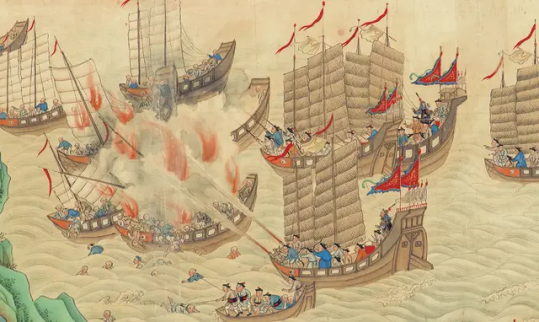
Qing Dynasty pirates were a unique fusion of bandit, mercenary, and drug smuggler. Obviously, if you planned on sailing through pirate-infested waters, you had better pay off the pirates to be left unscathed. Otherwise, your ship was getting plundered.
Qing pirates also offered up their talent for violence to the highest bidder during times of war. In the 18th century, Imperial Vietnam would frequently hire and train up Southern Chinese pirates to assist their fleets during naval battles. Those who earned merit during these conflicts would even be granted official military titles. In 1857, the Chinese government would even employ these same South Sea pirates to take down the Portuguese pirates terrorizing their waters.
Finally, as Qing Dynasty piracy reached its epoch at the same time as the First Opium War, Chinese pirates participated in a lot of drug smuggling. As pirates have no loyalty, they had no issue serving as middle-men in the profitable European drug trade.
Where were these pirates found?
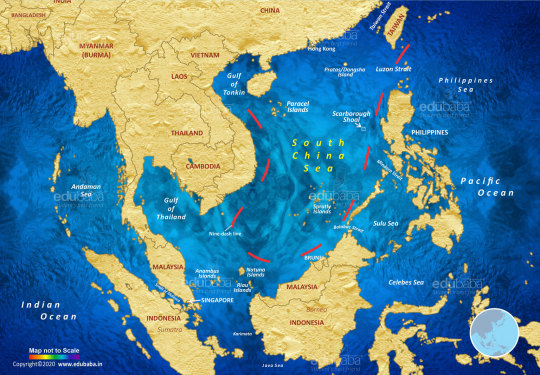
The South China Sea was the stomping ground for Qing-era pirates, particularly the Gulf of Tonkin. In terms of ports and towns, they tended to spend a lot of time in the border areas where China met Vietnam. Remember that these pirates offered their services to both Imperial Vietnam and Imperial China, so they didn't exactly have national loyalties.
#atla#avatar the last airbender#avatar#atlaculture#earth kingdom#vietnam#cultural fashion#cultural weapons#I went a bit overboard with this post#no pun intended#I'm just really into the idea of incorporating more Southeast Asian cultures into the ATLAverse#I also just think outlaws are kind of neat#replies
243 notes
·
View notes
Text
Okay I’ve noticed that in the tumblr gothic lit fandom discussions about racism (be it in-text or fandom racism) never go too far because if it’s a white person pointing something out (usually something blatant everyone can see) they’re accused of white saviorism and speaking over the people of color who are really affected by that racism- but if those people of color do it and call the racism out, they’re ignored. the only people of color that are listened to are the ones that say “it’s not that bad”, “I’m fine with it”, “I don’t mind it” as if they’re a monolith and other POC aren’t uncomfortable with the fandom’s behavior. and, listen, I don’t know if I -as a white person- am 100% right in this assessment, but it kind of… smells of tokenism?
#doc talks#gothic fiction#gothic literature#I think this is true of all fandoms tho but in this one it is more insidious#because it’s always like#’hey maybe don’t be like these old timey authors we read and fetishize Asian cultures?’#‘well you’re white so what do you know. anyway this Asian weapon is definitely used for sex things by my white fave’
62 notes
·
View notes
Note
bops you on the head gently with a feather duster
oh huh
Thank you?? I guess 😳
52 notes
·
View notes
Text
The sword of the day is the panabas.
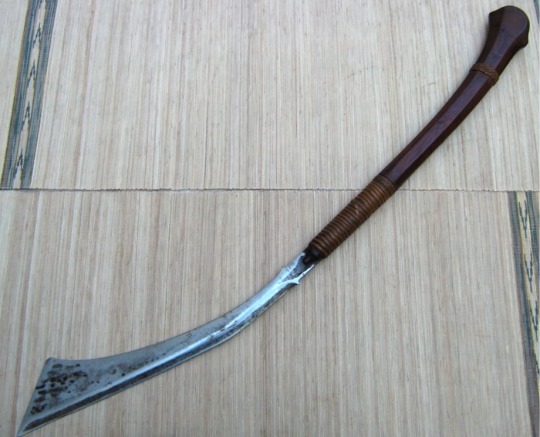
A blade from the southern Philippines, and the Moro tribes of Mindanao, the panabas was both a weapon and an agricultural implement. It is also known as the nawi, but I prefer the panabas name; it is a shortening of the words “pang-tabas,” meaning “chopping tool” and that is exactly what the panabas does. Blades varied in size, but could get as large as this massive two-handed example seen here. Though primarily used for chopping, there are examples with a point that would have made it an effective thrusting weapon as well.
Thank you to @kathanglangit for helping me write this one! If anyone reading happens to know about weapons, especially African or Chinese weapons, please let me know!
158 notes
·
View notes
Text
"historically polygamous societies loved to wage war and slavery to dispose of excess men and emphasize female conversion" okay all those things are true of monogamous societies too. Western Europeans are famously probably the best at war and slavery from the current standpoint and they're monogamous. And from the way you wrote that I can tell you were thinking of the middle east so what the fuck
#cipher talk#Many east and southeast Asian cultures are accepting of polygamy. They also don't really emphasize conversion AFAIK most of the time#So you're probably thinking of West Asia. And weaponizing my peoples trauma to make a stupid point#Because you don't actually care enough to research marital norms and how they impact human trafficking and genocide#And don't have the brains to understand thar the norms of a fundie community cannot extrapolate into a whole civilization#With no nuance cuz it'll collapse#Most Muslim men in history have had one wife. Because you can only have as many wives as you can afford to support#After that the common number is 2#Fundamentalist American polygamists often have FIVE TO TEN.#It's a completely different ratio with different social pressures#This is also ignoring that some sons in a whole society are not expected to have kids and have free avenues to not have kids#Instead of a cult where the choice is made for you#It's not a good situation. It's still heteropatriachy and there was indeed slavery. But it's not as extreme as fundies are in the US#Simply because discarding a significant portion of your male children by abandoning them or killing them isn't sustainable#And like. Monogamous societies do the same thing with how marital expectations intersect with genocide#Women are targeted in both instances because of their reproductive capacity and forced to assimilate/convert#To kill the culture in their generation and the next via marriage to the one targeting#A massive part of American history is doing this#And I don't mean just the US I mean both continents
8 notes
·
View notes
Text

Great Shirotori Armaments
大保護禅術刃 (Large Blade of Zen Protection Tactic)
A sword designed with one purpose in mind: Provide as much protection as possible.
The combat philosophy of the Shirotori focus on the Two Extremes: Full Aggressiveness and Complete Passivity. For a full understanding of this sword, we must look to the second.
Complete Passivity can be broken down into two modes of battle. One is the Body of Zen, the other the Kitsune Gambit. For today, we cover the Body of Zen.
The Body of Zen is simple: Stay (somewhat) rooted where you are and give as little ground as possible, focusing on keeping calm and patient, countering your opponent until you end up strong and are able to strike your opponent, ending the battle.
This sword was designed with that in mind.
It could be considered unwieldy, but only compared to a stock Katana. The guard is not all metal and the blade is large and dense enough to provide a fine enough balance to the blade, however it may prove difficult to carry around, as it does not have a Saya.
However, despite it's flaws, it's hand protection is unparalleled in the Two-Handed Blade field, only sacrificing more flashy tricks, but leaving room for any actual bladework to be done properly. At the front of the handguard and just above the hilt collar we have an area known as the Mountain of Jigoku, which once an enemy's blade is directed to, they are practically defeated.
The bottom of the 4-metal-pin full tang handle holds a small, spearlike blade that can be used if needed in grappling.
The blade is significantly more like a Dao or even a Messer in thickness and width, however the end is still razor-sharp for good follow-through.
This blade was designed by myself, the Young Master of Clan Shirotori, as i fiercely admire the tenets of Body of Zen techniques.
#asian weapons#sword fighting#sword#swords#sword design#worldbuilding#world design#martial arts#design#weapon design#conceptart#concept art#katana#lore#japanese culture#japanese#history#japan#culture#asia#samurai#war#creativity#art#shinto#japanese art
3 notes
·
View notes
Text
productivity day 10/100
(note: actually this is my productivity for the entire weekend but im just counting it as a day bc i didn’t do that much)
productivity rating: ★★★★
hours worked: 10

things i did:
- agro quiz
- last prep (watched a few videos, took a practice exam)
- did a lil bit of the ch 16 problem set
- worked on my grant application
- worked on my resume
- submitted a few internship applications
- made a rxn masterlist!
- did a ton of duolingo (2nd place 🥳)
- practiced dance! (we have new dances we need to learn lolol)
- memorized a few rxns
- public health quiz
- i did nothing for genetics 🤡🤡
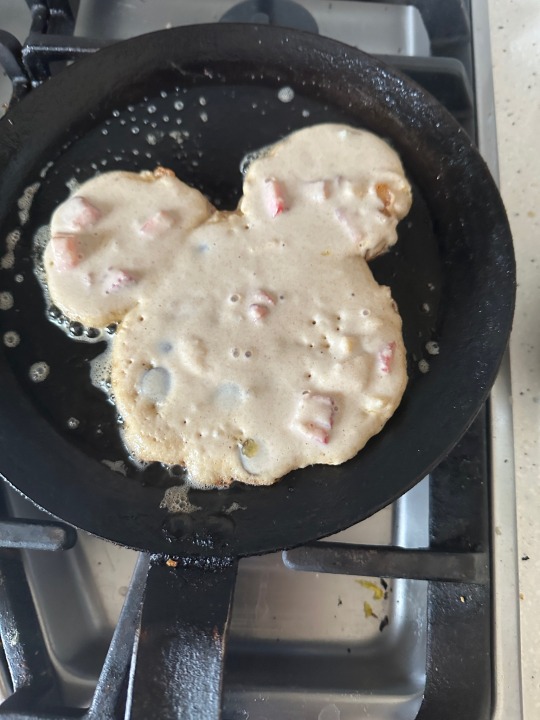

good news this week:
- my telehealth policy proposal was accepted!! i’m presenting it at a conference in april hehe :D
- got in contact w a ceo of a company im interested in!! we’re scheduled to get coffee together in march
- got a callback for an internship i applied to for the summer :D
#desi academia#academic burnout#studyblr#chaotic academia#productivity#100 days of productivity#asian parents#desiblr#academia aesthetic#academic validation#academic weapon
5 notes
·
View notes
Text




Chase the Truth - Ep. 7
3/3
Previous/Next
#whump#whump gifs#whump community#whump tropes#asian whump#injured#chinese drama#Chase the truth#one vs many#one man army#fight scene#falls on his knees#makeshift weapon#stabbed someone#tw blood#tw shaking
6 notes
·
View notes
Text
Food and Fights
Summary:
Hikaku knows the man he loves.
(He doesn't know Hashirama.)

Rating: Teen And Up Fandom: Naruto Relationship: Uchiha Hikaku/Uchiha Madara, Senju Hashirama & Uchiha Madara Word Count: 626 (Complete)
Entry for @asian-drama-tropes
July Tavern (fight scene optional but likely) | Lovers fighting back to back | Prosaic objects as weapons | Sweeper monk | "2 jin (1.2kg) of cooked beef and a pot of alcohol"
Part 7 of Secrets of the Heart

Hikaku sits down at the table, shuffling a little on the bench, and tilts his chin down to better hide his face.
The whole point of hiding themselves under these straw hats is for this meeting to pass unremarked upon, and he doesn't intend to be the reason for the daimyo to take official notice of it. Peace between the two strongest clans in Hi no Kunai has upset the balance of power enough already, and Madara-sama's plan to build a village to house all the shinobi in the country is the kind of thing that's better discovered after the fact than before.
"Two jin of cooked beef and a pot of alcohol," Madara-sama holds up three fingers as he orders their food. "Please."
The owner nods, bringing over cups and chopsticks, but scuttles away as a long shadow is cast over them.
"Drinks for three, eh? I'll take a share of that!" A big man abruptly sits down on the bench next to him, and Hikaku flicks his eyes over the intruder. Muscular certainly but, without the tell tale of weapons calluses on his hand and the chakra of a trained shinobi, he seems to be nothing more than a bully.
And Hikaku knows how his clan head responds to bullying.
Read the rest on AO3.
#asian-drama-tropes-2024#July | Prompt: Tavern#July | Prompt: Lovers fighting back to back#July | Prompt: Prosaic objects as weapons#July | Prompt: Sweeper monk#July | Prompt: Quote#Phlebas Writes#Naruto#fanfiction#Story: Food and Fights#Series: Secrets of the Heart#Uchiha Hikaku/Uchiha Madara#Senju Hashirama & Uchiha Madara#Uchiha Hikaku#Uchiha Madara#Senju Hashirama#okay to reblog
5 notes
·
View notes
Text
The sword of the day is the charay.
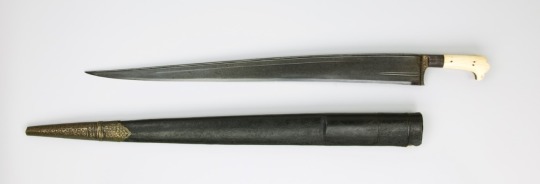
The charay, also known as the Khyber knife, is a short sword originating from the Khyber pass in Pakistan, though similar blades can be found throughout India and Persia. Despite its simple silhouette, it is a deceptively complex sword. The spine of the blade is raised, giving the blade a T-shaped cross section that lends it a tremendous amount of rigidity and strength despite its relatively thin blade.
219 notes
·
View notes
Text
Maki Zenin by xerenite

#xerenite#xerenite_#pretty girls#asian cosplayer#Maki Zenin#劇場版 呪術廻戦#Jujutsu Kaisen 0#ladies#cosplay#female cosplay#cosplay girls#manga cosplay#cosplay video#girl with a weapon
27 notes
·
View notes